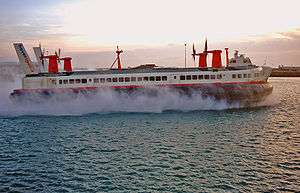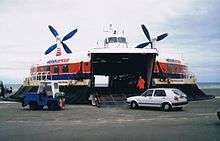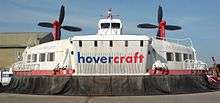SR.N4

The SR.N4 (Saunders-Roe Nautical 4)[1] hovercraft (also known as the Mountbatten-class hovercraft) was a large passenger and vehicle carrying hovercraft built by the British Hovercraft Corporation (BHC). BHC was formed by the merger of Saunders-Roe and Vickers Supermarine in 1966. Work on the SR.N4 began in 1965 and the first trials took place in early 1968. Power was provided by four Rolls-Royce Proteus marine turboshaft engines each driving its own lift fan and pylon-mounted steerable propulsion propeller.
The SR.N4 was the largest hovercraft built to that date, designed to carry 254 passengers in two cabins besides a four-lane automobile bay which held up to 30 cars. Cars were driven from a bow ramp just forward of the cockpit / wheelhouse. The first design was 40 metres (131 ft) long, weighed 190 long tons (193 t), was capable of 83 knots (154 km/h) and could cruise at over 60 knots (111 km/h).
The SR.N4s operated services across the English Channel between 1968 and 2000.
Service
The craft entered commercial service in August 1968, with the Princess Margaret (of British Rail's Seaspeed) initially operated between Dover and Boulogne but later craft also made the Ramsgate (Pegwell Bay) to Calais route. This craft was featured in the James Bond film "Diamonds Are Forever" in 1971. The journey time, Dover to Boulogne, was roughly 35 minutes, with six trips a day at peak times. The fastest ever crossing of the English Channel by a commercial car-carrying hovercraft was 22 minutes, recorded by the SR.N4 Mk.III Princess Anne on 14 September 1995,[2] for the 10:00 a.m. service.[3]
In 1972 the first SR.N4s were temporarily withdrawn for conversion to Mk.II specification which would provide for seven further car spaces and 28 more passengers. The first of the enlarged craft, the Swift, entered service at the beginning of February 1973.[4] The capacity increase was achieved by removing an inner passenger cabin in order to accommodate the extra cars and widening the outer passenger cabin: this was achieved without changing the overall footprint of the craft.[4] New aircraft-style forward-facing seats created an atmosphere of enhanced sophistication, and a redesigned skirt was intended to reduce window spray, enhancing the view out for passengers, and to give a smoother ride in rough seas: contemporary reports nevertheless commented on the "unsprung" nature of the ride.[4] From 1976 two SR.N4s were refitted with new deep skirts and stretched by almost 56.1 ft (17.1 m), increasing capacity to 418 passengers and 60 cars at the cost of a weight increase to almost 265 long tons (269 t). To maintain speed the engines were upgraded to four 3,500 shaft horsepower (2,610 kW) Rolls-Royce turboprops fitted with four 21 ft (6.4 m) diameter steerable Dowty Rotol propellers. The work cost around £5 million for each craft, and they were designated Mark IIIs; the improvements allowed them to operate in seas up to 11 ft 6 in (3.5 m) high and with 57.5-mile-per-hour (92.5 km/h) winds. The stretched SR.N4s (Super-4's) became the world's largest hovercraft, holding this title until the Russian Zubr class LCAC hovercrafts' arrival early in the 21st century.

The two main commercial operators (Seaspeed and Hoverlloyd) merged in 1981 to form Hoverspeed, which operated six SR.N4 of all marks. In all operations, while the craft were occasionally damaged, there was loss of life only once when on 30 March 1985 the Princess Margaret was blown onto a breakwater at Dover and four passengers were killed. The last of the craft was withdrawn from service in October 2000 and Hoverspeed itself ceased operations in November 2005.
Military
The Royal Navy considered a mine sweeping version of the SR.N4, hovercraft being almost invulnerable to mines. This never got further than the concept stage, although an SR.N3 was used by the Inter-Service Hovercraft Unit for trials.

Survivors
The two remaining Mk.III examples of the craft (GH-2006 Princess Margaret and GH-2007 Princess Anne) were bought by Wensley Haydon-Baillie for £500,000 and reside at the Hovercraft Museum. Haydon-Baillie is the owner of the super yacht Brave Challenger and uses the same Rolls-Royce Proteus Marine engines as the SR.N4s. The purchase included seven years' worth of spares including engines. As of winter 2015 all engines and APU's have been removed from the craft. The SR.N4s were put up for sale and Hover Transit Services of Bolton, Ontario, proposed putting the hovercraft back in operation (following a $10 million USD purchase and refurbishment) on Lake Ontario with service between Rochester, New York, and Toronto, Ontario.[5] The plan did not come to fruition, with government officials concluding that the organisation lacked the experience necessary to be viable.[6]
The land on which the Hovercraft Museum stands is owned by the Homes and Communities Agency. Proposed redevelopment of the site has led to the two craft being threatened with scrapping, but a petition was launched with the aim of preserving one of the craft,[7] which led in to a 3-year lease of the hovercraft to the museum in August 2016 with the intention of subsequently permanently handing over the hovercraft to the museum.[8]
The plastic construction kit company Airfix produced a 1:144 scale model of the SR.N4 in the early 1970s, with a clear plastic top decking to show the detailed interior.
Production
Built as Mk.I unless specified otherwise.
- 01 - GH-2006 Princess Margaret 1968, Seaspeed - originally the prototype, converted to Mk.III specification in 1979
- 02 - GH-2004 Swift, Hoverlloyd - converted to Mk.II specification for February 1973, broken up in 2004 at the Hovercraft Museum
- 03 - GH-2005 Sure 1968, Hoverlloyd - converted to Mk.II specification in 1972, broken up in 1983 for spares
- 04 - GH-2007 Princess Anne, Seaspeed - converted to Mk.III specification in 1978
- 05 - GH-2008 Sir Christopher 1972, Hoverlloyd - converted to Mk.II specification in 1974, broken up 1998 for spares
- 06 - GH-2054 The Prince of Wales, Hoverlloyd - built as Mk.II, scrapped in 1993 due to electrical fire.

Specification
Dimensions
- Length:
- Mark 1 and 2: 39.68 m
- Mark 3: 56.38 m
- Beam: 23.77 m
- Height: 11.48 m (on landing pads)
- Gross Weight
- Mark 1: 165 t
- Mark 2: 200 t
- Mark 3: 320 t
- Powerplant: 4 x 3,400 shp Rolls-Royce Proteus Gas turbines (3,800 shp in Mk.III)
- Load:
- Mark 1: 30 cars and 250 passengers
- Mark 2: 36 cars and 278 passengers
- Mark 3: up to 60 cars and 418 passengers (112 tonnes maximum)
Performance
- Max speed: Mark 1 - 65 knots (calm water, zero wind, at gross laden weight)
Mk.II - 70 knots (130 km/h) - Normal operating speeds: 40 - 60 knots (110 km/h)
- Endurance: 4 hours (maximum power, 2,800 Imperial gallons of fuel)
- Gradient: 1 in 11
See also
Notes
- ↑ "James' Hovercraft Site: SRN4". Retrieved 2008-03-22.
- ↑ "Hovercraft Facts". 1966: Hovercraft deal opens show. BBC. 15 June 1966. Retrieved 9 April 2010.
- ↑ "Hovercraft". Dover - Lock and Key of the Kingdom. www.dover-kent.co.uk. Retrieved 2008-01-23.
- 1 2 3 "Hovering along on the Crest of a Wave". Autocar. 8 February 1973. p. 6.
- ↑ "Can Fast Hovercraft Service Between U.S. And Toronto Stay Afloat?". CityNews. 9 April 2008. Retrieved 10 September 2010.
- ↑ "Has fast ferry idea's time passed?". Toronto Star. 15 July 2008. Retrieved 29 March 2013.
- ↑ "Petition to save last cross-Channel hovercraft". BBC. 30 January 2016. Retrieved 4 February 2016.
- ↑ "Cross-Channel hovercraft Princess Anne 'to open to public'". BBC News. 15 August 2016.
References
- Hovercraft Museum: SR.N4 Mk.I
- Hovercraft Museum: SR.N4 Mk.II
- Hovercraft Museum: SR.N4 Mk.III
- James' Hovercraft Site: SRN4
- Brave Challenger
External links
- SR.N4 Hovershow 05 Pictures
- SR.N4 Hovershow 04 Pictures
- Aerial photograph of the Hovercraft Museum Trust site showing the size of the SR.N4